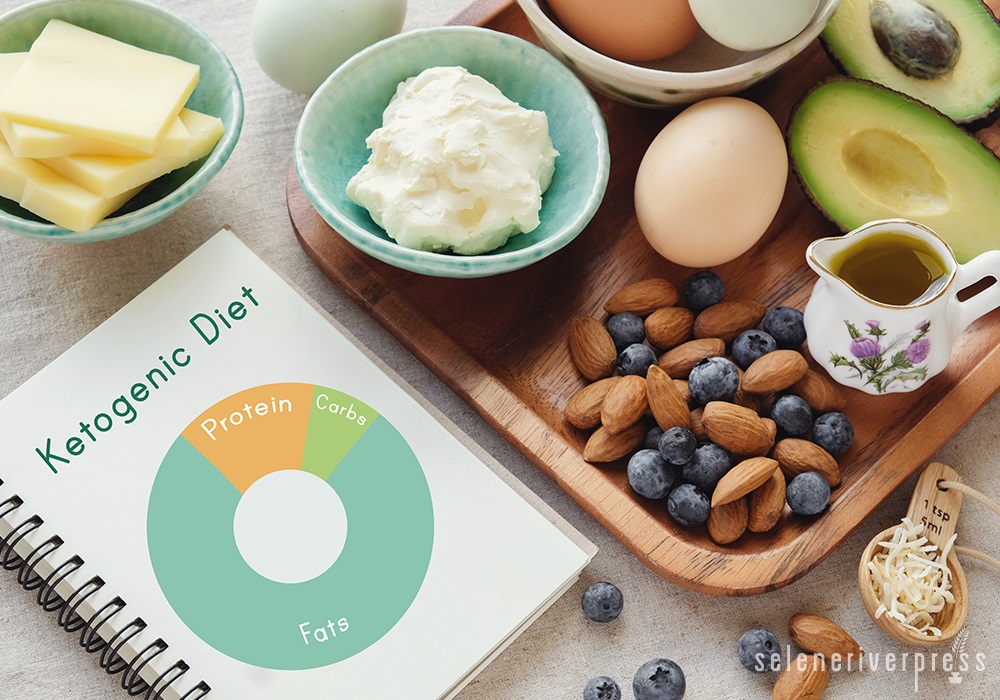Have you recently heard or read about people losing a ton of weight on a ketogenic diet? If you’re wondering if this is really possible—and if a keto diet may be right for you—today’s article can help. I’ll be covering the basics of a ketogenic diet, the potential health benefits of being in ketosis, and the four most important steps to follow if weight loss is your goal.
Let’s begin by discussing why keto may be unlike any other diet you’ve tried before.
What Is the Keto Diet?
A ketogenic diet is one that shifts the majority of your daily calories from carbs to fat. This means that “ketoers” limit their carb intake to roughly 20–50 gm per day, depending on their activity levels. It also means that they get most of their calories from healthy sources of fat, such as the following:
- Nuts (almonds and macadamia)

- Seeds (chia, pumpkin, and flax)
- Fatty fish
- Coconut oil
- Olive oil
- MCT oil
- Avocados
- Grass-fed butter
A common misconception about the ketogenic diet is that it’s high in both fat and protein. But to be clear, a proper keto diet isn’t high in protein. Keto dieters consume a moderate amount of protein based on their age, gender, activity levels, and weight loss goals.
It would be more accurate to say that a ketogenic diet is a high-fat, moderate-protein, and low-carb way of eating. This specific split of macronutrients leads to a state of ketosis, which has the added perk of shrinking your waistline and boosting your health.
What Is Ketosis?
Ketosis is a metabolic state that tells your body to use fat for fuel, rather than glucose from dietary carbohydrates.
When your body switches its source for fuel from carbs to fats, it produces ketones, which are simply energy molecules. This new source of fuel adds more pep to your step, but that’s not all. Being in a state of ketosis is also associated with the following:
- Better mental focus
- Reduced inflammation
- Fewer migraines
- Relief from depression
- Improved memory and cognitive performance
- Fewer seizures in children with epilepsy
- Relief from Alzheimer’s symptoms, including better memory
- Stable blood sugar levels
When it comes to weight loss specifically, another study finds that ketosis may lead to:
- Decreased BMI
- Improved cholesterol (increase in “good” HDL and decrease in “bad” LDL cholesterol)
- Lower triglyceride levels
- Decreased blood sugar levels
4 Steps to Losing Weight on Keto (The Right Way)
Now let’s find out how you can start taking advantage of these keto health benefits and shed those unwanted LBs. To make sure a keto diet works in your favor, you’ll need to follow these steps:
#1. Understand the keto diet: Before you radically change your diet, make sure you understand ketosis and how the keto diet works. Fortunately, there are many online ketosis resources that will help you get started ASAP.
#2. Determine your macronutrient and calorie breakdown: Once you know the keto fundamentals, your next step is to determine your macronutrient and calorie needs. These numbers are specific to your age, gender, weight loss goals, activity levels, and current health state. Since a one-size-fits-all number won’t work here, you’ll need to figure out your specific dietary needs on your own. This guide can help.
# 3. Stick to keto-approved foods and track your intake: Next, you’ll want to familiarize yourself with keto-friendly foods. This also means learning which foods to avoid in order to reach ketosis, which will help you shop for and create meals that meet both your macronutrient and calorie targets.
Start by measuring out proper serving sizes and logging your food intake to stay within your macro range. Be honest with your portion sizes and consistent with your food logging. If either one of those are off, you may not reach ketosis. You may even tip the scale in the opposite direction (read: gain weight) if you’re not careful.
# 4. Get at least 30 minutes of daily exercise: At least 30 minutes of daily low-intensity exercise will help you promote weight loss and feel more energized. These activities can include any of the following:
- Yoga
- Walking
- Bike riding
- Lifting weights
By sticking to your macros and staying consistent with your food logging and workout routine, you’ll get into ketosis fast and start shedding your unwanted weight in no time. You’ll also score the positive health benefits that come with reaching and maintaining ketosis that we discussed earlier.
If you’re considering a ketogenic diet, your first step is to learn more about it and find out what you’re really signing up for. A keto diet isn’t right for everyone, but it can certainly be an amazing tool if your goal is specifically to lose weight.
Images from iStock/ThitareeSarmkasat (main), AndreyPopov (woman), ThitareeSarmkasat (food).



